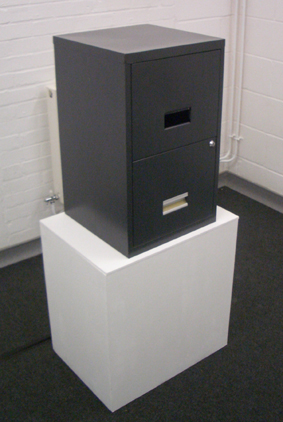
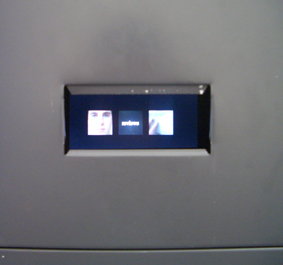
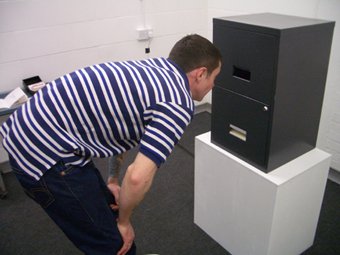
The
Exhibition for this Artefact was Thursday 1st to Friday 2nd
June 2006,
Reading Campus, TVU
Introduction
This
module was split into two sections: Proposal Presentation (completed)
and Development of an Artefact. This essay seeks to explain
the development of concept and give a post-analytical summary
of the exhibition for the artefact ‘Miniature Index’.
Most of this will be done within this essay but an accompanying
short film on DVD will support this work and can be found inside
the submission pack. If you are reading this without the pack
email: paul.glennon@tvu.ac.uk
The
logic behind splitting this module into a project proposal and
final artefact is simple and effective – present an emerging
idea halfway through the module, then develop that idea into
an actual working artefact. As the artefact for this work culminated
in an exhibition, it is recommended that the DVD is watched
either before or after reading this essay.
Beginnings
The
initial proposal started as a film in a box. The film explained
intentions through the use of a small screen implanted inside
a hand-made box isolating the screen. A documentary-style short,
filmed on a mobile, entitled ‘Paul’s Wee World in
a Box’ was the actual mobile phone screen itself, embedded
inside the structure. View this link.
The point of the box was to give people an insight into the
mind of Paul Glennon.
The box was influenced by Marcel Duchamp’s ‘Valise’
(Suitcase) series that house miniature re-creations of his artworks.
In ‘Paul’s Wee World in a Box’, the structure
became a miniature ‘one person film theatre’. (The
word ‘Miniature’ came from feedback from Mike Barker,
the tutor for this module, in reference to the small screen
world we are living in.)
The
proposal went well, but further development of the box was too
difficult. The box seemed to have served its purpose and the
concept needed to be pushed. The best option was to move the
contents, keeping the general idea but exploring greater possibilities.
Literary devices were used for inspiration especially the complex
thought processes in James Joyce’s ‘Ulysses’.
Jeri
Johnson, a Fellow in English at Exeter College, Oxford, wrote
in her introduction to James Joyce’s ‘Ulysses’
about the use of ‘interior monologue’:
‘a
literary technique capable of presenting directly without aid
of an intrusive omniscient narrator the most intimate, often
half-formed, only half-verbalized, thoughts of a character…’
(Johnson, 1998, p. 20)
Johnson
warns the reader not to confuse this with a ‘stream of
consciousness’ (a term first coined by the American philosopher,
William James) which describes the mechanistic workings of consciousness
in an individual as opposed to thoughts spilling onto a page.
For the development of the ‘Miniature Index’ a decision
was made to work somewhere in between the two, jotting down
random thought process when working on a creative problem, then
bringing order to the thoughts by indexing them into alphabetical
order.
Extending
and Exploring the Concept
To help with this it was deemed relevant to follow the ‘art
history trail’, after studying Duchamp’s ‘Valise’
artworks (see Project Proposal) – this led to one artist
in particular. Joseph Kosuth (b. 1945) was part of the ‘Siegelaub’
Conceptual Art movement in the 60’s. He was concerned
with Linguistic Philosophy, in particular dictionary definitions
and the basic use and understanding of ‘words’.
‘One and Three Chairs’ (1965/6 – below) is
an excellent example – in this work we find an actual
chair, a picture of a chair and a dictionary definition printed
on the gallery wall.
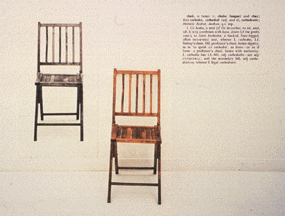
Kosuth
seems to question art in a basic way but at the same time seeks
to bring clarity to meaning.
‘The
task of art consists in constantly questioning its own essence
and, in extended analysis, to contribute to the clarification
of the question of what art is.’
(Marzona, 2005, p. 72)
As the end of this module began to loom
the non-movement of ‘Paul’s Wee World in a Box’
became a greater problem – the exact question of ‘What
is Art’ became problematic. However, in observing the
above comment about Kosuth it was noted that instead of a question
being asked, a statement might well be being made: not ‘What
is Art?’ but a suggestion of ‘What Art is’.
This
led the study into the difficult and confusing world of ‘Tautology’
(a statement that is necessarily true, The Concise Oxford Dictionary).
Kosuth explains this with the following: ‘art idea (or
work) and art are the same and can be appreciated as art without
going outside the context of art for verification.’ (Marzona,
2005, p. 72). There are many ways in which one can interpret
this statement, one perhaps being the seeking of clarification
from a given reference point when creating something (such as
art).
So,
in ordering ‘thought processes’ to be turned into
an art piece, it seemed advantageous to find a reference point
related to the basic principles of ‘the creative process’.
In the sketchbook for this module, words were jotted down describing
Paul Glennon’s creative process. The following words emerged:
Words,
Drawing, Sketchbook, Film, Exhibition, Discussion, etc.
These
words came quite easily and immediately the recollection of
Bruce Nauman’s work came into mind:
‘Work,
Work, Work, Work, Work, Work, Work, Work, Work, Work, Work,
Work, Work, Work, Work, Work, Work, Work, Work, Work, Work,
Work,…’
(Nauman, 2004, p. 31)
Last
year Bruce Nauman filled the Turbine Hall in the Tate Modern
with his sounds in an exhibition called ‘Raw Materials’.
The hall was simply filled with large speakers playing sounds
from his collected artworks. An excellent Web site accompanied
this exhibition which allowed you to hear the sounds and see
the artworks in their original state: click
here. One piece in particular comes to mind. From the Clown
Torture Series:
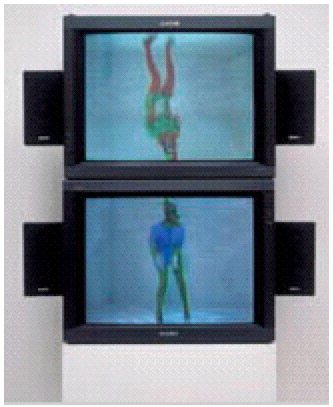 ‘Double No’, 1998
‘Double No’, 1998
The use of actual people in ‘Double
No’ makes the piece real. What better way to witness the
creative process of Paul Glennon than by direct observation
of his face speaking the words into a video camera? This made
up the first frame in the final artefact film.
By
now a clear interest in words had emerged and as this MA is
one of Computer Arts, what better way to create the words, while
they are being said, than by typing them? Not just typing them,
but recording the very keyboard being tapped and a video of
the letters appearing on a monitor. The third picture was simply
a physical representation of ‘words’ videoed from
a book. Thus a triptych film with movement and sound was born.

From
the observed creative process of Paul Glennon eleven key words
emerged in the sketchbook, and from the template of the first
triptych the entire piece was completed quickly. (See attached
CD with FLASH file. Note, this is only a part of the overall
artwork and should be viewed in the installation piece ‘Miniature
Index’.)
The
Actual Artefact
The
final decision to be made was how to display this video loop.
The original box had served its purpose so a new device had
to be constructed. Or did it? Within the sketchbook for this
module, many token ideas are drawn with the intention of solving
this issue, most of them unsuccessful. They generally tended
to look like ‘Punch and Judy’ stages that were designed
for the viewer to stick their head into – too elaborate!
It was not until the original starting point was reinvestigated
again that the idea took hold.
Within
the Project Proposal the hiding or isolating of the screen came
from a childhood obsession with a 3-D View Master. Children
could peer into the binocular-style headset whilst flicking
the disks to see the various images, giving them the opportunity
to shut themselves off from the surrounding world (for me West
Belfast, in the 70s and 80s). When you look inside the View
Master, peripheral vision is blocked due to the design of the
head set, thus making you look harder at the image. The idea
of making people look hard at moving image seemed important
– we see so much television and film but are we really
looking any more? It seemed important to make the observers
of this piece of work look harder and in turn reveal the working
processes in a more focused way.
The 3-D View Master was not an option as an
actual thing to look through, so, personal objects from the
past were hauled out of storage. An old filing cabinet that
had been lying around with no handle (it had been ripped off
by me in a fit of rage over three years ago) offered obvious
connotations but also harked back to the classic ‘ready-made’
artwork. With a laptop fitting neatly into the top drawer, ‘Miniature
Index’ was born. (The title of the piece had to be bashed
out in a tutorial with Mike Barker!) The best thing about the
filing cabinet was the height – it was a half size office
piece, and even on a plinth it required the viewer to bend down
to look in.
Exhibition
& Evaluation
The
exhibition of this work offered an opportunity to see the work
in situ. Colleagues and students entered the room; some were
puzzled at first, and then, hearing the sound were drawn to
peek inside. Most people bent down but some knelt in front of
it.
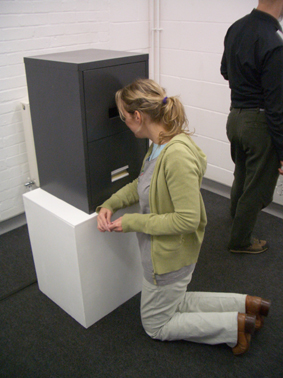
A
comment box on the side proved beneficial in collecting written
feedback (see DVD) and the actual sketchbook was popular with
visitors (pages can be seen on the Module 3 section at this
link.)
As
part of the Private View a Performance piece was worked into
the evening. The work was projected onto the wall and people
were videoed with Paul Glennon’s face on theirs (see DVD).
This was good interaction and encouraged more debate during
the evening.
The
most memorable thing about the evening was the fact that people
had to work hard to see the film, thus were more focused.
Final Note
This is the beginning not the end of this work. Recently the
filmmaker Peter Greenaway was quoted as saying that the potential
of film has not yet been explored to its maximum. The ways in
which we actually view moving image must be explored more if
we are to break free from what Greenaway calls a ‘steam-driven
19th century template of theatre and literary adaptation’.
Only then might we be able to engage with ‘the great art
of painting in motion’ (quoting Rudolf Arnheim in his
1957 book ‘Film as Art’).
References
Arnheim,
R, (1957) Film as Art
University of California Press
Bradshaw,
P (2006) Call that a Movie?
The Guardian / G2 / 16th May 2006 / p. 22 - 23
Joyce,
J (1998) Ulysses
Oxford World’s Classics / Edited with an Introduction
and Notes by Jeri
Johnson
Morzona,
D (2005) Conceptual Art
Taschen
Nauman,
B (2004) Bruce Nauman – Raw Materials
Tate
SLIDES
FROM THE EXHIBITION









Thank
you to all who helped and came to the Exhibition!